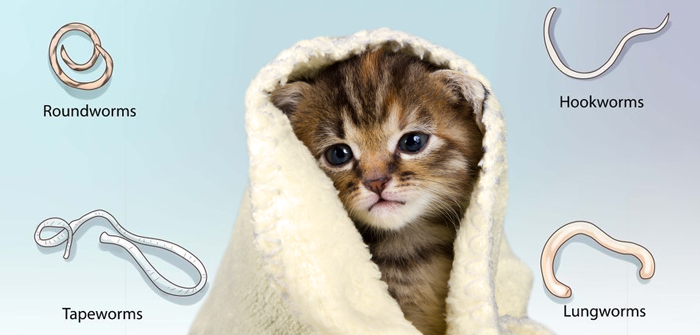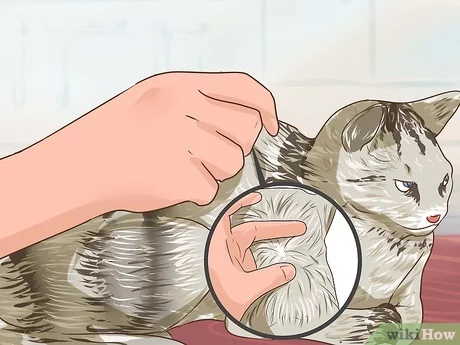To know if a cat has worms, look for signs like weight loss, vomiting, and a bloated abdomen. Additionally, check for visible worms in the feces or around the anus.
Cats are susceptible to various types of worms, including roundworms, tapeworms, and hookworms. These parasites can cause a range of health issues and discomfort for your feline friend. Recognizing the symptoms early can help in timely treatment and prevent complications.
Common signs include changes in appetite, lethargy, and diarrhea. Regular vet check-ups and maintaining a clean environment are crucial for preventing worm infestations. Treatments are available, and a vet can recommend the best course of action. Keeping your cat healthy involves vigilance and quick response to any signs of worms.

Credit: www.vetsupply.com.au
Common Symptoms
Cats with worms often show symptoms like weight loss, diarrhea, and a bloated abdomen. You might also notice visible worms in their feces or around the anus. Regularly monitor your cat’s health to catch these signs early.
Weight Loss
Cats with worms may experience unexplained weight loss. This happens because the worms steal nutrients from the cat’s body. You might notice that your cat eats normally but still loses weight. This is a clear sign that something is wrong. Always consult a vet if your cat is losing weight.
Vomiting
Vomiting is another common symptom of worms in cats. Your cat may throw up frequently. Sometimes, you might even see worms in the vomit. This is a strong indication that your cat needs medical attention. Frequent vomiting can make your cat weak and dehydrated. Always seek help from a vet if you notice this symptom.
Changes In Appetite
Your cat might eat a lot more than usual. This can be a sign of worms. Worms steal nutrients from your cat. So, your cat feels hungry all the time. Watch out for this change in eating habits. It is important to notice this early.
Sometimes, a cat with worms might not want to eat at all. This happens because worms can make your cat feel sick. Your cat might feel full even when it hasn’t eaten. This lack of appetite is a warning sign.
Digestive Issues
Cats with worms often have diarrhea. The stool might be soft or watery. Blood or mucus may appear in the stool. Frequent trips to the litter box can happen. This condition makes your cat very uncomfortable. Watch for signs of dehydration. Diarrhea can lead to dehydration quickly. Always keep fresh water available.
Constipation is another sign of worms in cats. Your cat may strain to pass stool. The stool might be hard and dry. This can cause pain during defecation. Less frequent bowel movements are common. Some cats may refuse to eat due to discomfort. Ensure your cat drinks plenty of water. Fiber-rich food can help ease constipation.

Credit: www.wikihow.com
Visible Worms
Spotting visible worms in your cat’s feces or around their anus indicates a worm infestation. Common symptoms include vomiting, diarrhea, and weight loss. Regular vet check-ups can help detect and treat these parasites effectively.
In Feces
Small white worms can be seen in the cat’s feces. They may look like grains of rice. These worms are usually still alive and moving. Finding worms in feces is a clear sign of infection. Take your cat to the vet if you see worms. Early treatment can prevent serious health issues.
Around Anus
Check the area around your cat’s anus. You may notice worms or segments. These can also look like small white grains of rice. Cats may drag their bottoms on the floor if they feel itchy. This behavior is another sign of worms. Regular vet check-ups can help detect and treat worms early.
Lethargy
Cats with worms may show decreased activity. They might not play as much as usual. You may notice your cat lying around more. This is a sign of lethargy.
Another sign is sleeping more than usual. Cats need rest, but too much sleep can be a problem. If your cat is napping all day, it could have worms.
Coat Condition
A cat with a dull or patchy coat might have worms. Look for excessive shedding and poor fur condition as indicators. Regular vet check-ups can help ensure your cat stays healthy and worm-free.
Dull Fur
A cat with worms may have dull fur. Healthy cats have shiny, smooth coats. Worms cause poor nutrient absorption. This leads to dull and rough fur. Regular grooming won’t help improve the coat.
Hair Loss
Worms can cause hair loss in cats. Patches of missing fur are common signs. Cats may scratch or bite their skin. This leads to more hair loss. Bald spots might appear on the body.
Behavioral Changes
Cats with worms often show signs of irritability. They may become more aggressive or easily annoyed. This behavior is due to the discomfort caused by the worms. You might notice your cat hissing or swatting more frequently. They might also become less tolerant of petting or handling. Changes in mood are common.
Restlessness is another sign of worms in cats. Your cat may have trouble settling down or finding a comfortable spot. They might pace around the house or seem unable to relax. This behavior is often linked to the discomfort from the worms. Cats may also have trouble sleeping or may wake up more often during the night. Pay attention to these changes in behavior.

Credit: www.dutch.com
Potbellied Appearance
A swollen abdomen in cats can be a sign of worms. The belly becomes round and firm. This is often called a potbelly. A cat with a potbelly may look like it has eaten too much. The swelling is due to the worms inside the cat’s stomach.
Bloating is another symptom to watch for. A bloated cat may feel uncomfortable. The stomach looks larger than normal. This happens because worms take up space inside the stomach. Your cat might also have trouble moving around. The bloating can make your cat feel sluggish.
Frequently Asked Questions
How Can You Tell If A Cat Has Worms?
Cats with worms may show signs like weight loss, vomiting, diarrhea, bloated belly, and visible worms in feces.
Can I Deworm My Cat Myself?
Yes, you can deworm your cat yourself using over-the-counter medications. Consult your vet for proper guidance and dosage.
What Does Cat Poop With Worms Look Like?
Cat poop with worms often contains visible white or beige worms. They look like spaghetti or rice grains.
How Can An Indoor Cat Get Worms?
Indoor cats can get worms from fleas, contaminated food, or by ingesting infected rodents and insects. Regular vet check-ups help.
Conclusion
Recognizing the signs of worms in your cat is crucial for their health. Watch for symptoms like weight loss, vomiting, or diarrhea. Regular vet check-ups can help detect and treat worms early. Keeping your cat’s living area clean also reduces the risk.
Stay proactive to ensure your feline friend stays healthy and happy.

Hello, this is Frank Swanson, the owner, and operator of Pet Info Hut. I created this website as a way to share my love of pets with the world. I have over 7 years of experience working with animals, and I have a passion for helping people care for their pets. I hope that you find my website useful and informative. Thanks for visiting!
